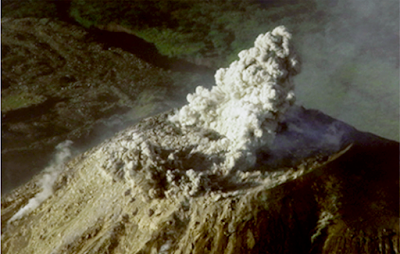
In contrast to the conventional view, new findings demonstrate that frictional heat in rising magma can drive outgassing of water vapor, which contributes to the dehydration of molten magma – and reduces the pressure in the system.
The lava dome of the volcano Santiaguito in Guatemala simmers away all day and all night: Clouds of ash belch from ring-shaped fissures around the mountain several times a day. The overlying crust of cool lava is torn apart at various points by mounting pressure from below, and the ash that is released can form overlapping rings. This unceasing activity is driven by frictional heat, as has now been demonstrated by an international team, which included a group of Munich volcanologists led by Donald Dingwell, Director of the Department of Earth and Environmental Sciences at LMU. The work is reported in the leading journal Nature.
The vent atop Santiaguito’s magma chamber is plugged by a flat crust of solidified lava, which forms localized bulges prior to an eruption and then subsides again. Ash issues from the vent only if this cycle of build-up and collapse is completed very rapidly, i.e., when the surface of the dome locally rises and falls by a meter – within a single second. Electron microscopic studies have revealed that the particles of ash that are expelled under these conditions are unusually inhomogeneous in structure and look as if they are shot through with vesicles. “We have observed similar inhomogeneities in laboratory experiments in which magma was rapidly heated by means of friction,” says Dingwell.
Through cracks in the lava dome
On the basis of these studies, the researchers concluded that a significant amount of frictional heat is generated as magma is forced through cracks in the lava dome, and that this heat suffices to melt the rock very rapidly. “As the magma rises, friction develops between the viscous material and its solid surroundings, and this interaction can raise the local temperatures by several hundred degrees Celsius,” Dingwell explains. This finding provides a new perspective on the play of forces which drives the outgassing of molten magma and, in particular, the expulsion of water vapor: Until now, it was assumed that the solubility of the gases in the magma, and hence the onset of foaming, is essentially determined by the local pressure – the higher the magma rises in the vent, the lower the pressure, and the lower the solubility of the dissolved gases. So bubbles begin to form, rise to the surface and the magma starts to foam.
“But the solubility of water vapor also depends on the local temperature – the hotter things get, the less water can be kept in solution,” says Dingwell. The volcanologists therefore experimentally measured the interrelationships between temperature, pressure and the solubility of water vapor in magma. The results reveal that the level of frictional heat generated as magma rises in the conduit – and not so much the fall in pressure – is often the factor that determines the point at which outgassing of water vapor, and thus foaming of the magma, takes place. “Foaming increases the buoyancy of the magma, but foaming magma is also less stable and more readily fragments – and this helps to relieve the stresses in the system,” says Dingwell. “This is presumably the reason why eruptions at Santiaguito have not produced any large-scale explosions recently. The magma rises very rapidly through the network of fissures, producing so much frictional heat that it foams. Foaming in turn relieves the tensions and stresses within the system so effectively that the volcano remains in an active but stable state overall,” Dingwell concludes.
Reference:
Yan Lavallée et al. Thermal vesiculation during volcanic eruptions, Nature (2015). DOI: 10.1038/nature16153
Note: The above post is reprinted from materials provided by Ludwig Maximilian University of Munich.









